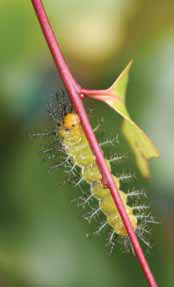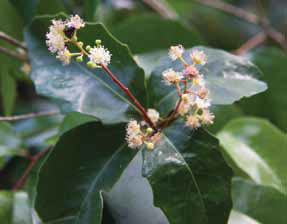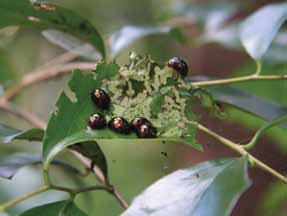The Bordered Rustic has returned to Brisbane thanks to the efforts of Dale and other landholders. Shown above is the adult butterfly and below is the larvae.

Much of the work in restoring native plant communities is focussed on removing weeds and establishing a framework of plants similar to ecosystems that existed before they changed. However, sometimes the focus is on providing specific plants which will encourage specific fauna. This is exactly what Dale Borgelt (Land for Wildlife member and member of the Richmond Birdwing Conservation Network and Moggill Catchment Group) has done in the western suburbs of Brisbane.
With friends and neighbours, Dale has planted many Flintwood (Scolopia braunii) which is the food plant for the caterpillar of the Bordered Rustic butterfly (Cupha prosope).
This brown and orange butterfly frequents creek and river forests and the margins of rainforest, but only occurs where its local food plant, Flintwood, exists.
The reason Dale and her friends made a big effort by planting Flintwood to encourage the Rustic back to the western suburbs was that one of its major habitats near Brisbane was destroyed in the 1980s to create a new housing estate. Essentially, no adequate known breeding habitats for Rustics remained in the suburbs of Brisbane.
Although Dale had grown Flintwood since 1990, she had not seen Rustics breeding locally for many years. So in 2003 she commenced her restoration program by buying Flintwoods wherever she could and encouraging friends and neighbours to plant them in their yards and properties.
Gradually she noted more and more Rustics emerging and breeding each year. Now in 2011 these beautiful butterflies have re-established breeding populations in Brisbane, possibly after migrating back from Central and North Queensland in autumn following good rains.

Most of the recent sightings of Bordered Rustics have been in the western suburbs but others have also turned up in eastern suburbs and south of Brisbane.
Bordered Rustic should not be confused with the other common orange and brown butterflies such as the wanderers and leafwings. Wanderers are usually found in open country and are quite a bit bigger (Rustics have a wingspan of 60 mm, wanderers are 100 mm).
Bordered Rustic butterflies lay small, round eggs singly on young leaves of Flintwood; however, many times Dale has found the egg laid on spiderwebs on Flintwood plants. The pupa is attached and suspended below a leaf or twig and is bright green with silver spots and has several long spines that stick out from the pupa.

This past year, Dale assisted these butterflies in her own garden by reducing the number of other insects that eat the same young leaves as the Rustic caterpillars. A small beetle often out- competes the Bordered Rustics and she regularly collected these beetles and disposed of them thoughtfully. This meant there has been plenty of young leaf to support an increased breeding population and the reward has been Rustics on display since late October 2010 until July this year.
A great attribute of this butterfly is that they will quite happily stay low to the ground and fly near people so you can enjoy them up close.
If you want to restore the Bordered Rustic in your area, it may be as simple as planting more Flintwood trees. Dale has also planted host plants for most other species of butterfly found in South East Queensland – an impressive and inspiring story.
For more information about planting Flintwood for the Bordered Rustic, you can contact Dale Borgelt on 3374 1035 or [email protected]
References
Orr A and Kitching R (2010) The Butterflies of Australia. Allen and Unwin.
Braby, MF (2000) Butterflies of Australia: Their Identification, Biology and Distribution. CSIRO Publishing.
